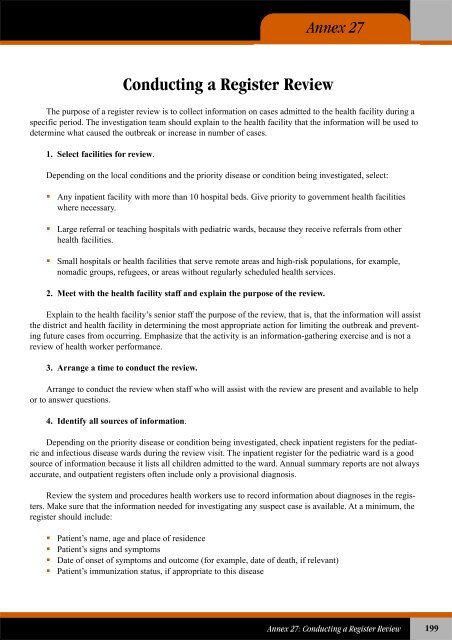Technical Guidelines for Integrated Disease Surveillance ... - PHRplus
Technical Guidelines for Integrated Disease Surveillance ... - PHRplus
Technical Guidelines for Integrated Disease Surveillance ... - PHRplus
Create successful ePaper yourself
Turn your PDF publications into a flip-book with our unique Google optimized e-Paper software.
Annex 27Conducting a Register ReviewThe purpose of a register review is to collect in<strong>for</strong>mation on cases admitted to the health facility during aspecific period. The investigation team should explain to the health facility that the in<strong>for</strong>mation will be used todetermine what caused the outbreak or increase in number of cases.1. Select facilities <strong>for</strong> review.Depending on the local conditions and the priority disease or condition being investigated, select: Any inpatient facility with more than 10 hospital beds. Give priority to government health facilitieswhere necessary. Large referral or teaching hospitals with pediatric wards, because they receive referrals from otherhealth facilities. Small hospitals or health facilities that serve remote areas and high-risk populations, <strong>for</strong> example,nomadic groups, refugees, or areas without regularly scheduled health services.2. Meet with the health facility staff and explain the purpose of the review.Explain to the health facility’s senior staff the purpose of the review, that is, that the in<strong>for</strong>mation will assistthe district and health facility in determining the most appropriate action <strong>for</strong> limiting the outbreak and preventingfuture cases from occurring. Emphasize that the activity is an in<strong>for</strong>mation-gathering exercise and is not areview of health worker per<strong>for</strong>mance.3. Arrange a time to conduct the review.Arrange to conduct the review when staff who will assist with the review are present and available to helpor to answer questions.4. Identify all sources of in<strong>for</strong>mation.Depending on the priority disease or condition being investigated, check inpatient registers <strong>for</strong> the pediatricand infectious disease wards during the review visit. The inpatient register <strong>for</strong> the pediatric ward is a goodsource of in<strong>for</strong>mation because it lists all children admitted to the ward. Annual summary reports are not alwaysaccurate, and outpatient registers often include only a provisional diagnosis.Review the system and procedures health workers use to record in<strong>for</strong>mation about diagnoses in the registers.Make sure that the in<strong>for</strong>mation needed <strong>for</strong> investigating any suspect case is available. At a minimum, theregister should include: Patient’s name, age and place of residence Patient’s signs and symptoms Date of onset of symptoms and outcome (<strong>for</strong> example, date of death, if relevant) Patient’s immunization status, if appropriate to this diseaseAnnex 27: Conducting a Register Review199















